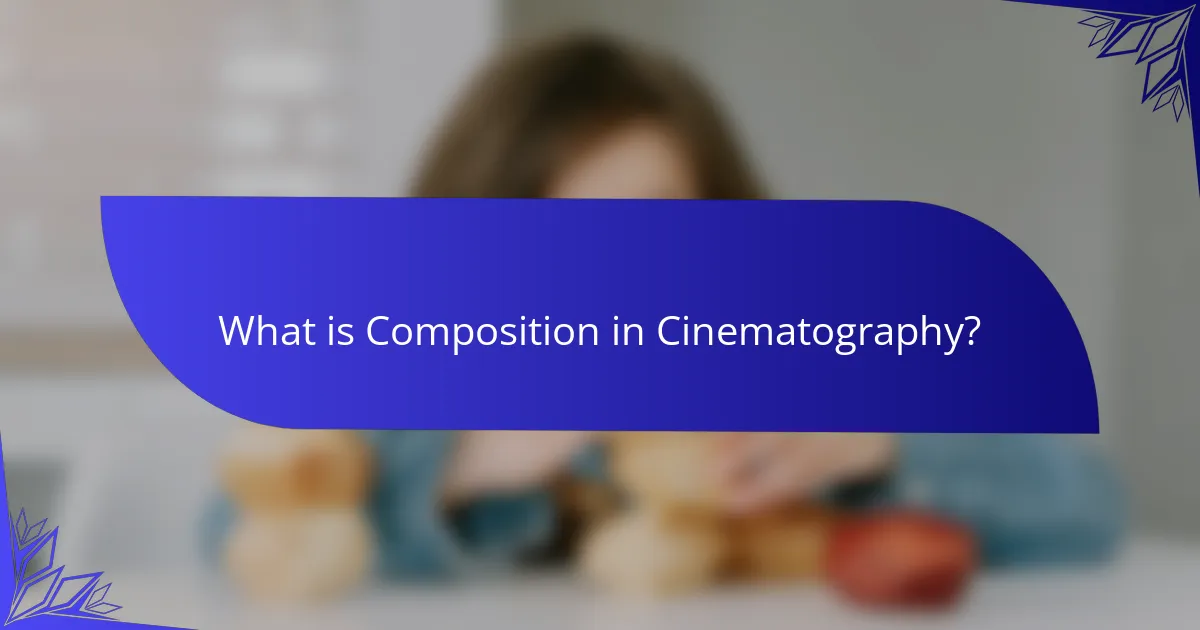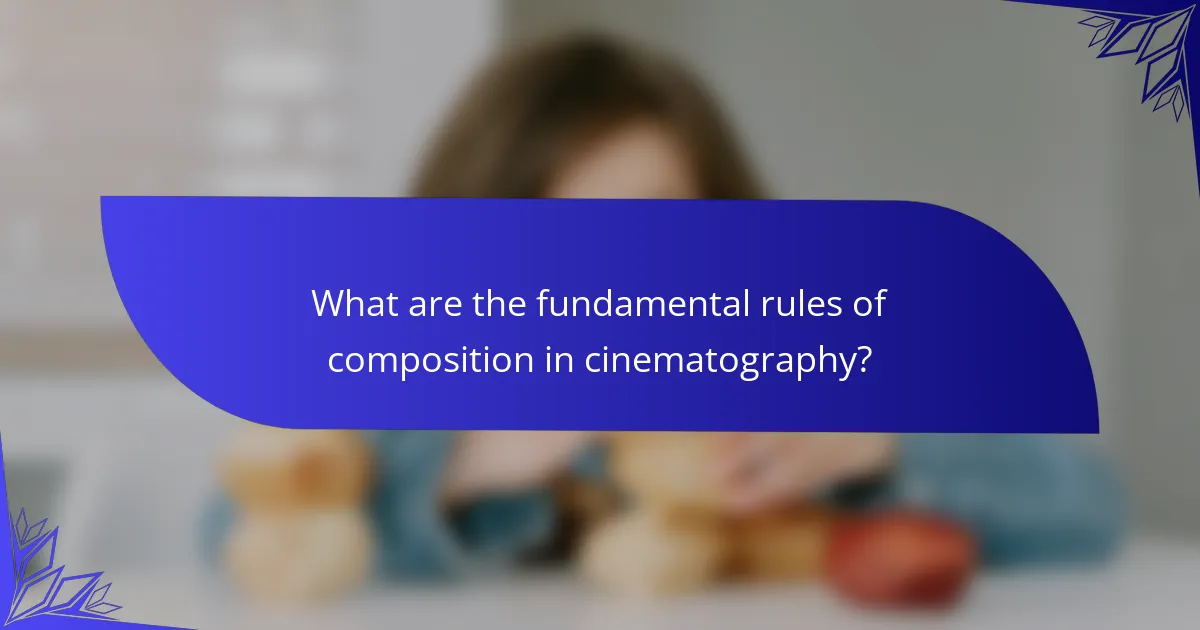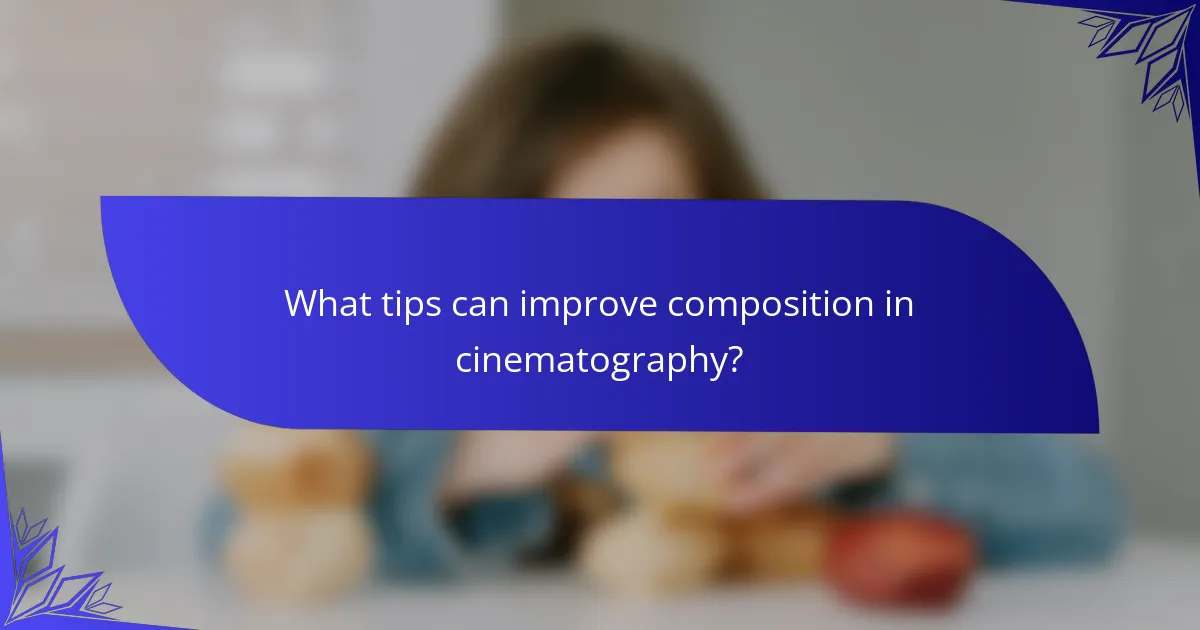Composition in cinematography is the arrangement of visual elements within a frame, crucial for effective storytelling. Key concepts include the rule of thirds, leading lines, framing, and balance, which guide the viewer’s eye and enhance visual appeal. Techniques such as dividing the frame into a 3×3 grid, using natural elements to frame subjects, and experimenting with angles are essential for improving composition. This article provides an overview of these fundamental rules and practical tips to elevate cinematographic composition, ensuring a cohesive visual narrative that evokes emotions and establishes context in film production.

What is Composition in Cinematography?
Composition in cinematography refers to the arrangement of visual elements within a frame. It involves the strategic placement of subjects, objects, and backgrounds to create a cohesive visual narrative. Effective composition guides the viewer’s eye and enhances storytelling. Techniques such as the rule of thirds, leading lines, and framing contribute to strong composition. For example, the rule of thirds divides the frame into a 3×3 grid, positioning key elements along these lines. This method is widely utilized in professional cinematography. Proper composition can evoke emotions and establish context, making it essential in film production.
How does composition influence visual storytelling?
Composition significantly influences visual storytelling by guiding the viewer’s attention and conveying meaning. It determines how elements are arranged within a frame. This arrangement affects the emotional tone and narrative clarity of a scene. For instance, the rule of thirds creates balance and focuses attention on key subjects. Leading lines can direct the viewer’s gaze towards important elements. Additionally, symmetry can evoke feelings of harmony or tension, depending on context. A well-composed shot enhances the story’s impact by making it visually engaging. Studies show that viewers respond emotionally to compositional techniques, reinforcing their connection to the narrative.
What are the key elements of visual composition?
The key elements of visual composition include balance, contrast, emphasis, movement, pattern, rhythm, and unity. Balance refers to the distribution of visual weight in a scene. Contrast highlights differences between elements, enhancing visual interest. Emphasis directs attention to a focal point, guiding the viewer’s gaze. Movement creates a sense of action or flow within the composition. Pattern involves the repetition of elements, adding texture and depth. Rhythm establishes a visual tempo through the arrangement of elements. Unity ensures all components work together cohesively, creating a harmonious image. These elements are foundational in effective cinematography and visual storytelling.
How does composition affect audience perception?
Composition significantly influences audience perception in cinematography. It determines how viewers interpret visual elements within a frame. Effective composition guides the audience’s attention and shapes emotional responses. For instance, the rule of thirds can create balance and focus, enhancing engagement. Conversely, cluttered or poorly structured compositions can lead to confusion or disinterest. Studies show that well-composed scenes evoke stronger emotional reactions. For example, a symmetrical composition often conveys harmony, while asymmetry can create tension. Thus, composition is a critical tool for filmmakers to control audience perception and emotional impact.
Why is composition important in cinematography?
Composition is important in cinematography because it shapes how viewers perceive a scene. Good composition guides the audience’s attention and conveys emotions effectively. It establishes a visual hierarchy, leading the viewer to focus on key elements. Techniques like the rule of thirds enhance balance and interest in the frame. Proper composition can evoke specific feelings, such as tension or harmony. Studies show that well-composed shots are more engaging and memorable. For instance, a study by the American Psychological Association found that viewers respond more positively to balanced compositions. This reinforces the significance of composition in storytelling through visual media.
What role does composition play in creating mood and atmosphere?
Composition significantly influences mood and atmosphere in cinematography. It determines how elements are arranged within the frame. The placement of subjects can evoke feelings of tension or tranquility. For example, a centered subject may create a sense of stability. Conversely, off-center subjects can induce unease or dynamism. Additionally, the use of lines and shapes directs the viewer’s attention. Diagonal lines often suggest movement or conflict. Color choices within the composition also affect emotional responses. Warm colors can create a sense of comfort, while cool colors may evoke sadness. Ultimately, effective composition guides audience perception and emotional engagement.
How does composition contribute to the narrative flow?
Composition shapes the narrative flow by guiding the viewer’s attention and enhancing storytelling. It establishes visual hierarchy, directing focus to key elements. Effective composition uses framing, balance, and symmetry to create a cohesive visual experience. This helps convey emotions and themes clearly. For instance, the rule of thirds positions subjects strategically within the frame, influencing how the story unfolds. Additionally, varying shot sizes and angles can depict character relationships and dynamics. Research shows that well-composed shots improve audience engagement and comprehension of plot developments. Thus, composition is crucial for maintaining a fluid narrative flow in cinematography.

What are the fundamental rules of composition in cinematography?
The fundamental rules of composition in cinematography include the rule of thirds, leading lines, framing, and balance. The rule of thirds divides the frame into a grid, placing points of interest along the lines or intersections. Leading lines guide the viewer’s eye through the scene, creating depth. Framing involves using elements within the scene to create a frame around the subject, enhancing focus. Balance ensures visual stability by distributing elements evenly across the frame. These rules enhance storytelling and visual appeal by directing audience attention effectively.
What is the Rule of Thirds and how is it applied?
The Rule of Thirds is a compositional guideline used in visual arts, including cinematography. It divides an image into nine equal parts by two horizontal and two vertical lines. This technique helps to create balance and interest in a composition. Placing key elements along these lines or at their intersections draws the viewer’s eye. For example, a horizon line placed on the top third creates a sense of openness. Similarly, positioning a subject at an intersection can enhance focus. This method is widely recognized in photography and film. It is often taught to beginners for improving composition skills. Studies show that images aligned with this rule are perceived as more aesthetically pleasing.
How does the Rule of Thirds enhance visual interest?
The Rule of Thirds enhances visual interest by guiding composition through strategic placement of subjects. This technique divides an image into nine equal parts using two horizontal and two vertical lines. Key elements are positioned along these lines or at their intersections. This creates balance and encourages viewer engagement. Studies show that images aligned with this rule are perceived as more dynamic and appealing. The human eye naturally gravitates towards these focal points, enhancing storytelling through visual hierarchy. Effective use of the Rule of Thirds can lead to more compelling and memorable images.
What are common mistakes when using the Rule of Thirds?
Common mistakes when using the Rule of Thirds include misplacing focal points. This often results in unbalanced compositions. Photographers may also ignore the grid entirely. This leads to centering subjects unnecessarily. Another mistake is overusing the rule in every shot. This can create repetitive and uninspired images. Additionally, failing to consider the subject’s movement can disrupt the composition. Lastly, not adapting the rule for different aspect ratios may limit creativity.
What is Leading Lines and how does it work?
Leading lines are compositional elements in photography and cinematography that guide the viewer’s eye toward a specific point in the image. They can be natural or man-made lines, such as roads, rivers, or architectural features. These lines create a sense of depth and perspective, making the composition more dynamic. Leading lines can also enhance storytelling by directing attention to the subject. For example, a road leading to a horizon can evoke a journey or adventure. The use of leading lines is supported by principles of visual perception, which suggest that viewers are naturally drawn along lines. This technique is widely taught in photography and cinematography courses as a fundamental aspect of composition.
How can leading lines guide the viewer’s eye?
Leading lines are visual elements that direct the viewer’s eye towards a specific point in an image. They can be natural features like roads, rivers, or fences. These lines create a pathway that draws attention and provides depth. By guiding the viewer’s gaze, leading lines enhance the composition and storytelling of a scene. Studies show that images with leading lines are more engaging, as they create a sense of movement and direction. This technique is widely used in cinematography to emphasize subjects and create visual interest.
What are examples of leading lines in famous films?
Examples of leading lines in famous films include the use of roads, railways, and architectural elements. In “The Shawshank Redemption,” the prison walls create a leading line towards freedom. “Inception” features city streets that bend and twist, guiding the viewer’s eye. “The Grand Budapest Hotel” uses symmetrical hallways to draw attention to characters. “Blade Runner” incorporates neon signs and streets to lead the viewer’s gaze. These visual techniques enhance storytelling and direct focus within scenes.

What tips can improve composition in cinematography?
To improve composition in cinematography, utilize the rule of thirds. This technique divides the frame into a 3×3 grid. Place key elements along these lines or at their intersections. This creates balance and interest in the shot. Additionally, consider leading lines to guide the viewer’s eye. These lines can be roads, pathways, or other elements in the scene. Another tip is to frame subjects with natural elements. This adds depth and context to the shot. Finally, experiment with different angles and perspectives. Unique viewpoints can enhance storytelling and visual appeal.
How can lighting affect composition?
Lighting significantly affects composition by influencing visibility, mood, and focus within a scene. It can create depth and dimension through shadows and highlights. Different lighting angles can alter the perception of shapes and forms. For example, side lighting enhances textures, while backlighting can create silhouettes. The color temperature of light also impacts the emotional tone of a composition. Warmer light can evoke comfort, while cooler light can suggest detachment. Studies show that well-planned lighting can improve audience engagement and narrative clarity. Thus, effective lighting is crucial for achieving desired compositional effects.
What techniques can enhance lighting in composition?
Techniques to enhance lighting in composition include the use of key lighting, fill lighting, and backlighting. Key lighting provides the main source of illumination, creating depth and dimension. Fill lighting softens shadows created by the key light. Backlighting adds separation between the subject and background, enhancing visual interest.
Using natural light can also enhance composition. It creates a more organic feel and can be manipulated through time of day. Reflectors can bounce light onto subjects, improving exposure and detail. Additionally, colored gels can alter the mood by changing the light’s hue.
These techniques are widely used in cinematography to create visually compelling images. Proper application of these methods can significantly impact the overall aesthetic of a scene.
How does natural light differ from artificial light in composition?
Natural light differs from artificial light in composition primarily in its spectral distribution. Natural light, such as sunlight, contains a full spectrum of wavelengths, including ultraviolet, visible, and infrared light. This broad spectrum allows for accurate color rendering and natural skin tones in photography and cinematography.
In contrast, artificial light sources, like incandescent or LED bulbs, often have a limited spectral range. Many artificial lights emit a narrower spectrum, which can result in color distortion. For example, some artificial lights may lack significant blue wavelengths, affecting the overall color balance in a scene.
The composition of natural light changes throughout the day, influenced by atmospheric conditions. This variability adds depth and richness to visual compositions. Artificial lights, however, provide consistent output but may require color correction to match the qualities of natural light.
Overall, the differences in spectral composition affect how subjects are illuminated and perceived in cinematography.
What are some common compositional techniques to consider?
Common compositional techniques in cinematography include the rule of thirds, leading lines, and framing. The rule of thirds divides the frame into a 3×3 grid. Placing subjects along these lines creates balance and interest. Leading lines draw the viewer’s eye toward the subject. This technique enhances depth and perspective in the shot. Framing involves using elements in the scene to create a frame around the subject. This technique emphasizes the subject and adds context. Other techniques include symmetry, depth of field, and contrast. Symmetry provides a sense of order and harmony. Depth of field controls focus, guiding viewer attention. Contrast highlights differences in light or color, adding visual interest. These techniques are essential for effective visual storytelling in cinematography.
How can framing and perspective change a scene’s impact?
Framing and perspective significantly alter a scene’s impact by influencing viewer perception and emotional response. Framing determines what elements are included or excluded from the shot. This choice affects focus and attention, guiding the audience’s interpretation. For example, a close-up can evoke intimacy, while a wide shot can create a sense of isolation. Perspective, on the other hand, shapes the viewer’s spatial understanding of the scene. A low angle can make a subject appear powerful, while a high angle can render them vulnerable. Research shows that these techniques directly affect audience engagement and emotional reactions. For instance, studies in visual perception indicate that framing can enhance narrative clarity and emotional resonance.
What is the significance of negative space in composition?
Negative space in composition is significant as it enhances visual clarity and focus. It refers to the area surrounding the main subject. This space helps to define the subject and create balance in the composition. Effective use of negative space can lead to a more engaging image. It allows viewers to breathe and process the visual information. Artists often employ negative space to guide the viewer’s eye. Historical examples include works by artists like Henri Matisse, who utilized negative space to emphasize form. Studies in visual perception indicate that negative space can influence emotional response and interpretation.
What are practical examples of effective composition in cinematography?
Effective composition in cinematography can be illustrated through several practical examples. The rule of thirds is a fundamental technique. It involves dividing the frame into a 3×3 grid. Key subjects are placed along these lines or at their intersections. This creates balance and visual interest.
Leading lines guide the viewer’s eye toward the subject. Roads, rivers, or architectural features can serve as leading lines. They enhance depth and perspective in a shot.
Framing uses elements within the scene to create a ‘frame’ around the subject. Doorways or windows can effectively frame a character. This technique adds context and focus.
Symmetry creates visually pleasing images. When subjects are centered, it evokes a sense of harmony. Many classic films utilize symmetry to enhance storytelling.
Depth of field isolates the subject from the background. A shallow depth of field blurs distracting elements. This technique emphasizes the subject’s importance.
These examples demonstrate effective composition techniques in cinematography. Each method enhances storytelling and viewer engagement.
How do different genres utilize composition uniquely?
Different genres utilize composition uniquely by employing distinct visual strategies. For example, horror films often use tight framing to create a sense of claustrophobia. This technique enhances tension and evokes fear in viewers. In contrast, romantic comedies frequently utilize wide shots to capture interactions between characters. This approach fosters a sense of connection and warmth. Action films, on the other hand, often employ dynamic angles and rapid cuts. These choices heighten excitement and urgency during crucial scenes.
Documentaries typically use naturalistic compositions to convey authenticity. This style helps ground the audience in reality. Each genre’s unique composition choices serve to reinforce their narrative goals and emotional impacts. According to a study by Bordwell and Thompson in “Film Art: An Introduction,” these compositional techniques directly influence audience engagement and interpretation.
What can we learn from analyzing iconic scenes in films?
Analyzing iconic scenes in films reveals essential elements of storytelling and cinematography. These scenes often showcase effective use of composition, lighting, and camera angles. Understanding these techniques enhances appreciation for visual storytelling. Iconic scenes also highlight character development and emotional impact. For example, the shower scene in “Psycho” demonstrates suspense through editing and sound design. Such analysis can inform filmmakers about audience engagement and narrative pacing. Ultimately, studying these scenes provides valuable insights into the art of filmmaking and the emotional resonance of visual media.
Composition in cinematography is the arrangement of visual elements within a frame that enhances storytelling and guides viewer attention. This article explores key compositional techniques such as the rule of thirds, leading lines, and framing, which contribute to visual interest and emotional engagement. It discusses how effective composition influences audience perception and narrative flow, outlining fundamental rules and common mistakes. Additionally, the article examines the impact of lighting and negative space on composition, providing practical examples and insights into how different genres utilize composition uniquely.